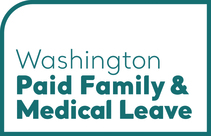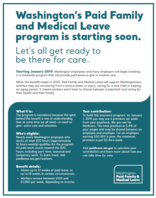Email four of five
Note: This email in the series covers explaining Paid Family and Medical Leave to your employees. If you don't have employees, you may disregard.
 About this message: This is the fourth email in a five-part series designed to help employers prepare for the legal requirements that kick in on Jan. 1, 2019. To read the previous emails in the series, go to www.paidleave.wa.gov/newsroom. For more information now, visit http://www.paidleave.wa.gov/employers.
About the program: In 2017, Washington’s Legislature passed a paid family and medical leave law. Starting in 2020, Washington will be the fifth state in the nation to offer paid family and medical leave benefits to workers. A premium of employee gross wages will fund the program, with the cost shared by both employees and many employers. The Employment Security Department (ESD) administers the program.
|
Almost every Washington employee will be eligible to receive benefits and almost every business in Washington (including businesses of all sizes and non-profits, charities and faith organizations) will participate.
Starting Jan. 1, 2020, employees who have worked 820 hours in the qualifying period (equal to 16 hours a week for a year) will be able to apply to take paid medical leave or paid family leave. The 820 hours are cumulative, regardless of the number of employers or jobs someone has during a year. All paid work over the course of the year counts toward the 820 hours, including part-time, seasonal and temporary work.
Unlike the federal Family and Medical Leave Act (FMLA), employees of small businesses may take Paid Family and Medical Leave if they meet the standard eligibility requirements.
 |
|
If you choose to deduct premiums from your employees' paychecks on Jan. 1, 2019, you may want to share the employee paystub insert with them to explain the new withholding.
Download and print to share with employees. It's available in English, Spanish, and twelve other languages.
|
Employers, HR or payroll are the first place most people will go when they notice new deductions from their paycheck. To help assist you in informing your employees of this new program and benefits, we’ve provided sample communications for you to share in the "About the benefit" and "Sample text for a workplace blog, newsletter or email" below. Additional content is available in our Employer Toolkit.
The law requires you to inform your employees about their rights under Paid Family and Medical Leave by posting a notice in a place where you customarily post employment-related notices. However, there are details about the program that are required to be printed on the poster but are still being negotiated through rulemaking. We anticipate the final version of the poster will be available in late 2019.
Note: These materials are not offered, nor should they be construed, as legal advice. It is strongly advised that you have your company attorney review the draft before preparing your final copy.
Paid Family and Medical Leave allows eligible employees to take up to 12 weeks, as needed, if they:
- Welcome a child into their family (through birth, adoption or foster placement).
- Experience a serious illness or injury.
- Need to care for a seriously ill or injured relative.
- Need time to prepare for a family member’s pre- or post-deployment activities, as well as time for childcare issues related to a family member’s military deployment.
If employees face multiple events in a year, they may be eligible to receive up to 16 weeks, and up to 18 weeks if they experience a serious health condition during pregnancy that results in incapacity.
Starting in 2020, Washington will be the fifth state in the nation to offer paid family and medical leave benefits. This benefit offers partially paid leave to care for yourself or a loved one in times of serious illness or injury, to bond with a new child joining your home through birth, adoption or foster placement, and for certain military-connected events if you have a family member in active duty service.
As a worker in Washington, you will experience a few changes in 2019. In your first paycheck of 2019, you might notice a new deduction. For example, if your gross wages are $50,000 per year, you may pay up to about $2.44 from per week. Employers contribute to this program too, so we’re in this together.
In 2020, you will be able to apply for leave when you experience a qualifying event and have worked 820 hours (about 16 hours a week, on average) in the year leading up to your date of leave.
This isn’t like paid sick leave; you will file your claim with the Employment Security Department (ESD), and your payment will come from ESD. Typically, you’ll have access to up to 12 weeks of paid leave. You can learn more at www.paidleave.wa.gov/workers.
Do you have questions? Ask your HR representative or ask your questions directly to the Paid Family and Medical Leave program at paidleave@esd.wa.gov. You can also find them on Twitter, Instagram and Facebook @PaidLeaveWA.
There is still time to get ready for Jan. 1, and we’re here to help. This email series walks you through preparing for the Paid Family and Medical Leave requirements that kick in on Jan. 1, 2019. Look for the final email in the series next week. To read previous emails in the series, visit the Newsroom on our website.
You can also get more information at any time by going to www.paidleave.wa.gov/employers and:
El 1 de enero, las empresas de todos los tamaños empezarán a deducir primas para el programa “Paid Family & Medical Leave” (Permiso de cuidado pagado). Este programa estatal de seguro ofrecerá a todos los empleados que cumplan con los requisitos hasta 12 semanas de permiso pagado, que se podrán tomar a partir del 2020. Es muy fácil empezar y hay ayudas económicas especiales para negocios pequeños.
|